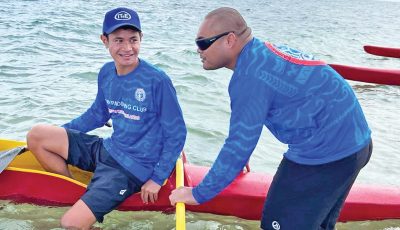New fish species found in New Caledonia
NOUMEA, New Caledonia—Pierre and William Larue were boating on July 29, 2014, near Tombo Reef, close to Boulari Boat Pass, when they spotted a small silver fish floating on the water.
Pierre Larue took high-resolution photos straight away that he sent to a journalist, who then contacted Gérard Mou-Tham, an IRD (French Development Research Institute) fish scientist. The fish did not match any lagoon specimens, so another IRD researcher, Dominique Ponton, suggested it might be a hatchetfish of the Polyipnus genus, a deep-water fish.
When an article appeared in the press, Secretariat of the Pacific Community taxonomist Elodie Vourey examined the fish. While she was familiar with this fish family, she had never seen this species before and decided to write a description of the specimen, which she sent to Antony Scott Harold, a hatchetfish expert and professor at College of Charleston in the United States who confirmed that it indeed was a new species.
The new fish, Polyipnus laruei, is named after yachters Pierre and William Larue who discovered it. After more than two years’ work, the description of the new fish species has been officially approved by Zootaxa scientific journal.
The description work was done by Elodie Vourey, Cyndie Dupoux, a technician managing invertebrate collections at the Paris Natural History Museum, and Antony Scott Harold.
The specimen was examined from every angle in challenging circumstances. It had to remain intact, because it was the only available specimen and would become the reference deposited at MNHN. SPC and IRD twice tried unsuccessfully to catch other specimens of the fish during missions in the area.
The first stage was to write a detailed description of the fish. X-rays were made of it to examine its morphology and the number of vertebrae. A genetic test was conducted on one of its fins and we compared our specimen with other fish of the same genus in the MNHN collection. The authors of the article chose to name the fish after its discoverers to acknowledge them and congratulate them on their curiosity.
Throughout the process, Pierre and William Larue were kept informed of progress. “It’s been a wonderful adventure,” they said. “We thought it was a known species and that we were just going to give you a specimen […] it’s amazing the fish caught the interest of scientists and it all led to a publication.”
It was also an exciting adventure for Elodie. “I’m delighted to be able to give this new species William and Pierre’s surname,” she said. “If it hadn’t been for them, we could not have done this work. They had the presence of mind to take snapshots of the fish immediately, freeze it and contact some scientists. This team work has been a memorable experience of curiosity, sharing and enthusiasm.”
The ocean is teeming with yet more unclassified species, particularly in the high seas and deep waters, and SPC and IRD have started a three-year endeavor to improve our knowledge of offshore ocean species off New Caledonia and Wallis & Futuna under Biopelagos, a European Union-funded BEST 2.0 programme project.
Like Pierre and William Larue, boating enthusiasts can contribute to this important work. If you find a species that looks unusual to you during an outing, collect the specimen, take good photographs of it, place it in your esky and then freeze it. Then contact IRD or SPC scientists. (SPC)



























